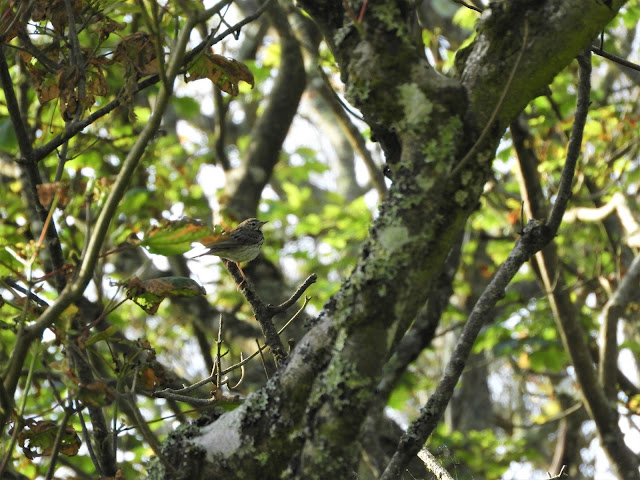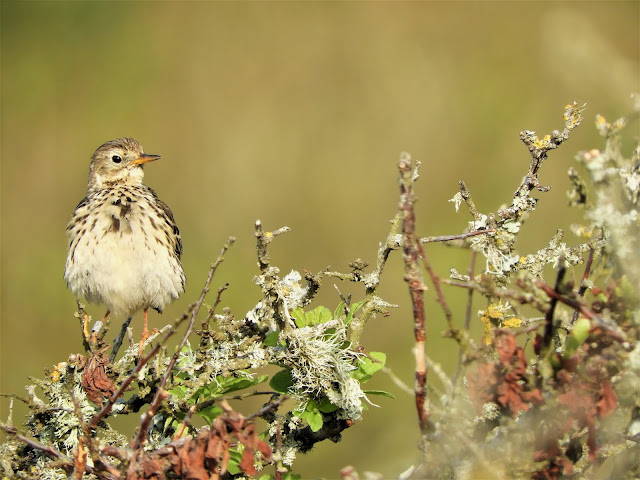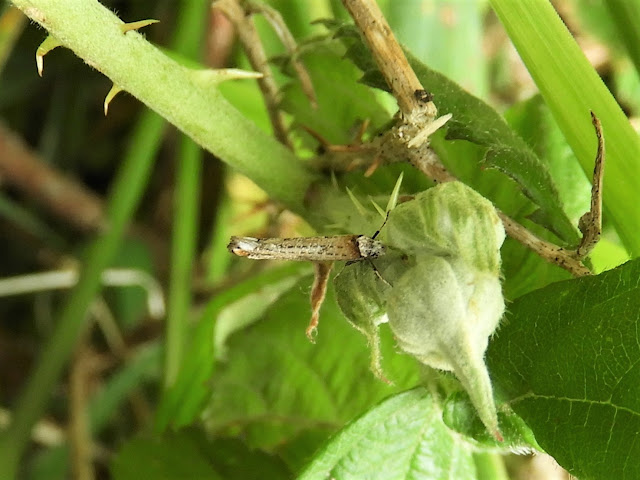It has been a month of superlatives for Lundy birds and other wildlife. What better way to celebrate Midsummer's Day than with a veritable feast of all the latest natural history goings-on in a superb round-up from Lundy Warden Dean Woodfin Jones.
What a momentous month of June it has been so far! Leading on from the last blog, this eventful summer period has seen the island welcome numerous researchers and students, the first school groups of the year for an exciting day of exploration with Education Officer Rosie Ellis, and we’ve also been entertaining lots of visitors with guided walks with the help of our Lundy Ambassadors. Our seabird productivity monitoring has also been keeping us busy, and lots of work has gone into the clearance and upkeep of the island's footpaths – most of which are growing over at a frantic pace as the vegetation makes the most of the long summer days.
What's more, the island is looking absolutely stunning at the moment, with swathes of Lundy cabbage, thrift, foxgloves and hogweed in bloom along the slopes and cliffs – all accompanied by an incredible diversity of insects, including clouds of day-flying micro-moths, mobs of Yellow Dung Flies and the cuckoo-spit from numerous leafhoppers coating nearly every frond of bracken in some places. The seas have been particularly clear of late too, allowing superb views of iridescent ctenophores, shimmering sand-eels and moon jellies galore.
Weather-wise, things have been mostly settled, with plenty of sunshine, light winds, clear skies and warm temperatures (between 14°C and 21°C). As always, however, there have been a handful of dull and mizzly days too, particularly on the 9th, 10th, 14th, 19th and 20th when the island was subjected to light drizzle, thick fog and mist from dawn to dusk.
The undoubted birding highlight of this period was the occurrence of Britain’s first Sulphur-bellied Warbler in Millcombe on the 8th. This individual decided to drop in next to the dustbins at the Old Lighthouse – where it was initially picked up by David Price whilst emptying his moth trap!! – instead of heading to its normal breeding range spanning from north-west Afghanistan and south-east Kazakhstan eastwards to central China, from its wintering grounds in northern and central India. A truly astonishing record! A full account of the momentous events of that day, written by David Price, Paul St Piérre and Dean Jones, can be found on the BirdGuides website: https://www.birdguides.com/articles/rarity-finders-sulphur-bellied-warbler-in-devon/
 |
| The photo that sparked a Twitter storm... Sulphur-bellied Warbler, Millcombe, 8 Jun © Dean Jones |
 |
| Some of the lucky few twitchers who arrived on the evening of 8 Jun © Dean Jones |
 |
| This lost traveller from Asia showed well for the assembled throng but moved on overnight and was nowhere to be found on 9 Jun, to the disappointment of many... © Dean Jones |
Other rarities since the last post include a Subalpine Warbler and a female Hawfinch in Millcombe on the 9th, two birds which provided meagre consolation to the multiple observers who missed out on the Sulphur-bellied Warbler on this date. Due the driech, drizzly conditions on the 9th & 10th, both birds remained in the valley until the 11th at least.
Lundy also managed to jump in on the Rose-coloured Starling invasion bandwagon on the 14th, with Ranger Matt Stritch finding a stonking adult bird in the Camping Field. Unfortunately, this day too was one of the few when the island was cloaked in thick fog, but observers still managed some nice views of the bird as it made its way around the Village and Lambing Shed before disappearing into the murk at around 11:00 hrs.
Unsurprisingly, coming further into June, bird migration slowed to but a trickle. Migrants of note from this period included small numbers of Swift which passed overhead most days – some already appearing to be on their way south, with a flock of 15 observed leaving the island towards Hartland Point on the 20th. Singles of Cuckoo were sighted on the 6th, 7th, 8th and 21st, two Collared Doves hung around on the island from the last post up until the 12th, singles of Cormorant and Grey Heron were noted on the 12th and 20th respectively, and a Kestrel was recorded on five dates at the start of the month, but unfortunately there have been no further signs since the 9th – fingers had been crossed for a second year of breeding success after young fledged in 2020.
Migrant passerines included small numbers of House Martin moving overhead on a number of days (max 13 on the 11th), up to two Willow Warbler on three dates, a single Sedge Warbler singing most days below Government House, providing a nice backing track to our beloved Song Thrush, which is still giving it large from the treetops in Millcombe each morning. Singles of Reed Warbler were noted on the 4th, 16th and 23rd, up to four Whitethroat over ten dates, and singles of Spotted Flycatcher on three dates.
 |
| Male Whitethroat singing in Millcombe, 4 Jun © Dean Jones |
Furthermore, a Greenland Wheatear was caught and ringed in South West Field on the 6th, singles of Tree Pipit and Yellow Wagtail were noted on the 15th & 12th respectively, and up to three Siskin were noted on three dates (one male of which was in song in Millcombe on the 16th).
On the seabird front, the island welcomed some very special guests from the RSPB on the 3rd. Paul St Piérre, Helen Booker, Jaclyn Pearson and Anthony Bellamy arrived on the island to join Lundy seabird legends, David Price and Peter Slader, who arrived a few days prior, for a week of counting each and every cliff-nesting seabird around Lundy’s coastline.
These counts have been carried out every four years since 1981, with the results providing us with great insights into how Lundy’s seabird populations have changed over the last 40 years. One of the most striking results from this survey is how the island's seabirds have recovered since the eradication of rats during the period 2004 to 2006. Most folk who know Lundy know that saying goodbye to the rats has seen an incredible recovery for some species, particularly Manx Shearwater, which are now at least 5,504 pairs strong (at the last survey in 2017/2018) – up from the 297 pairs in 2001. But how have the cliff-nesting seabirds done in comparison?
Well, the results from this month’s survey are incredible! Auks in particular are doing really well on the island with a mind-blowing 9,880 Guillemots, 3,533 Razorbills and 848 Puffins counted. These counts are up significantly from those done immediately prior to the eradication of rats from the island (2,348 Guillemots, 950 Razorbills and 13 Puffins in 2000), illustrating the extent to which these rodents were limiting the numbers of seabirds trying to breed on the island.
Shags, Fulmars and Kittiwakes are all up too from the last full census, which is also very heart-warming – particularly so the Kittiwakes which have undergone a drastic overall reduction in numbers during the 40 years of surveying. Unfortunately, the island's large larids, i.e. Herring, Lesser Black-backed and Great Black-backed Gulls, are down again on previous counts, though the precise extent of this is still to be worked out. The reasons for the decline in gull numbers are likely to be complex, but in the case of Kittiwake, at least, are probably driven in large part by climate change-related shifts in food availability.
So incredibly, all-in-all, including the burrow-nesting Procellariforms (Manx Shearwater & Storm Petrel), there are now over 26,000 seabirds breeding on Lundy – up from 7,351 prior to rat eradication. Truly jaw-dropping stuff! On top of this, the team also managed to confirm a new breeding site for Storm Petrel along the east coast – another species which is taking full advantage of the island now the rats have gone (the first confirmed breeding of Stormies was in 2014). A HUGE thank you to David, Peter, Helen, Paul, Jacqui and AJ for all their hard work – and a HUGE thank you to all of those who have been a part of or helped with the Seabird Recovery Project in some shape or form – you should all be so proud!
On the seabird productivity front, the season is now well and truly in full swing, with thousands of young seabirds hugging the cliffs and slopes awaiting fishy delights from mum and dad. The St Mark’s Guillemots are having another good year, with over 200 developing chicks in the plots now – some of which, from 20th June, have already made the jump to journey out into the high seas! Kittiwake nests are also bustling with young birds – the first chicks appearing in Aztec Bay on the 11th – two days earlier than the first of 2020. Meanwhile, Fulmars are still sitting tight on eggs at Gannets' Rock (currently 31 apparently occupied nests) and Puffins are busy delivering fish to youngsters in burrows (160 to date) at Jenny’s Cove.
 |
| St Mark's Stone Guillemots – how many chicks can you spot? 15 Jun © Dean Jones |
 |
| Digiscoped shot of a Kittiwake with its two chicks, west coast © Dean Jones |
Manx Shearwaters have also been getting lots of attention throughout this period, with Tim Frayling, Bart Donato and Richard & Rebecca Taylor all heading down to the west slopes for a spot of ringing over four nights. Combined efforts resulted in the capture and ringing of a total of 169 new birds, plus an additional 52 retraps (i.e. ringed on Lundy prior to 2021), including 26 birds which were ringed as chicks (and two which were ringed as chicks as early as 2019)!
The island Conservation Team also managed some time to check in on the shearwater nestboxes on the 17th. Thankfully all six pairs which had been recorded by Tony Taylor in May were all still present and accounted for, with five adults still sitting tight on eggs and another in box D1 with the first fluffy chick of the year!
Landbirds have also been very busy tending to eggs and young chicks. Wheatears have seemingly had a very productive season, with noisy gangs of young birds on nearly every buttress and drystone wall around the island. The first Linnet (15th), Chaffinch (19th), Pied Wagtail (22nd), Meadow Pipit (19th) and Wren (23rd) fledglings have also been recorded. Successful breeding of Teal was confirmed on the 3rd, with a number of ducklings following mum on the fringes of Pondsbury. Second broods of Starling chicks have also taken wing (15th) and at least three pairs of Swallow are currently on the island, though it seems that only one pair has actually got eggs at the moment.
 |
| There are loads of Wheatear fledglings around the island currently. This soggy-bottomed individual was on Tillage Field wall, 20 Jun © Dean Jones |
 |
| Second-brood Starling fledgling, Laundry Garden, 15 Jun © Dean Jones |
 |
| Adult Dunnock checking that the Warden is keep his distance from newly fledged young! Millcombe, 14 Jun © Dean Jones |
 |
| Millcombe is full of the calls of young birds, including this juvenile Robin near the Secret Garden, 21 Jun, © Dean Jones |
Away from birds, the first week of June is also the time when the island's endemic Lundy Cabbage is counted along the east slopes and cliffs. Alan & Sandra Rowland from the Lundy Field Society arrived on the 3rd to carry out the 28th annual count of our cherished brassica – the first having been carried out in 1993. These counts consist of both land- and water-based surveys, the latter involving a jaunt along the east coast on the Warden's RHIB on the 7th. Results show an overall increase in the estimated number of flowering plants on the island since 2019 (no survey in 2020 due to Covid-19), with 8,200 flowering plants in total! This is up 3,200 from the 2019 survey and 2,952 flowering plants more than the island average (the maximum number recorded to date was 13,000 in 2014). A huge thank you to Alan and Sandra once again for all their hard work and top-class company!
 |
| The Conservation Team with Alan Rowland (centre) all at sea counting brassicas off the east coast, 7 Jun © Dean Jones |
Now onto the invertebrates! Emperor Dragonflies are now on the wing, with single insects on the 15th and 16th at Threequarter Wall and Halfway Wall respectively. Small numbers of Blue-tailed and Common Blue Damselflies were noted at Quarter Wall Pond on the 15th.
Butterflies have been on decent form, with the first Meadow Brown of the year on the 12th, good numbers of Common Blue (max 10 on the 7th) and Small Heath (max 75 on the 4th) – particularly on the warm calm days. Painted Lady, Red Admiral, Peacock, Small, Large and Green-veined White have all been logged too in small numbers.
Continuing on the lepidopteran front, the month of June has also seen lots of moth-trapping action, with David Price, Andrew Cleave and the Conservation Team all regularly setting out light-traps. Highlights of recent efforts (other than the discovery of the Sulphur-bellied Warbler!) included three Privet Hawk-moths, two caught on the night of the 16th in Millcombe and the other at Benjamin’s Chair on the 22nd. Although these fantastic, exotic-looking moths are fairly common in the southern half of Britain, these three constituted the first for the island! As the name suggests, the larvae feed on privet and ash trees – which Lundy does have in very small numbers. Have these moths always occurred here though? Moth recording has been carried out ad hoc on Lundy since 1877 and, until now, this species has never been seen here, so perhaps these individuals had been blown over to the island on the recent bout of strong easterlies. The Benjamin’s Chair individual suggests just that. Either way, a fantastic record for the island, and with multiple individuals reaching us this spring, will we be seeing more of this beautiful moth in years to come near its available food plants? Only time will tell!
 |
| Privet Hawk-moth, Millcombe, 16 Jun 2021 © Dean Jones |
 |
| The three trapped so far this month are the first for the island! 16 Jun © Dean Jones |
From mega to micro – a single Pseudoswammerdamia combinella micro-moth was found in Millcombe on the 21st, which, like the hawkmoths, was also the first record for Lundy. The discovery of this species was perhaps less of a surprise as the larvae feed on blackthorn – a plant which is plentiful in the valley.
Although finding a new moth species for the island is always a highlight, it was the strange form of a familiar species which stole the show this period. Opening the moth trap on the morning of the 23rd revealed a peculiarly coloured Buff Ermine – a species which is common and sometimes abundant on Lundy. As you can see from the photos, the animal is sporting the dark colour-form zatima, which is very rare in the wild. Looking closer however, it was only the left side of the moth that was exhibiting this form. This individual is a very rare and unusual tetragametic chimaera – a rare condition that occurs through the fertilization of two separate ova by two sperm, followed by the aggregation of the two blastocyst/zygote stages to form one individual of two halves. Or put simply, an animal which is formed from the merging of two non-identical twins. What a moth!
 |
| The rare and bizarre tetragametic chimaera Buff Ermine, Millcombe, 23 Jun © Dean Jones |
 |
| The aberrant moth's underside – it was released unharmed after its photocall! © Dean Jones |
Other noteworthy moths have included the second record of Garden Pebble and the third record of Agonopterix subpropinquella for the island, both of which were caught in Millcombe. Additionally, good numbers of nationally scarce moths, such as Devonshire Wainscot (three), Barrett’s Marbled Coronet (14) and Thyme Pug (one), were caught at Benjamin’s Chair on the 21st. Migrant moths have included small numbers of Diamond-backed Moths and Silver Y on three dates, along with singles of Hummingbird Hawkmoth along the west coast on the 7th and 15th, Rusty Dot Pearl in the Millcombe Heath Trap on the 19th, and a Bordered Straw near Brazen Ward on the 3rd.
Back out on the high seas, small pods of Common Dolphin have been noted throughout, including a group of five animals riding the bow of the RHIB on the 6th. Around 20 animals were seen offshore from the Landing Bay on the 12th, six off Long Roost on the 13th, and five (perhaps the same animals) along the east coast on the 15th.
 |
| Common Dolphin alongside the RHIB, east coast, 6 Jun © Dean Jones |
A huge thank you to all who contributed sightings to this bumper blog post: Ben Arkless, Chris & Carol Baillie, Zoë Barton, Anthony Bellamy, Helen Booker, Bart Donato, Rosie Ellis, Tim Frayling, Eleanor Grover, Owen Hodson, Dean Jones, Jaclyn Pearson, David Price, Peter Slader, Paul St Piérre, Matt Stritch, Richard & Rebecca Taylor and Tony & Ann Taylor.















No comments:
Post a Comment